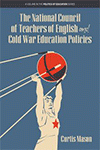
The National Council of Teachers of English and Cold War Education Policies
By:
Curtis Mason, University of Illinois at Urbana-Champaign
A volume in the series: PEA Series. Editor(s): Kyle Ingle, University of Louisville. Catherine DiMartino, St. John’s University.
Published 2020
The launching of Sputnik in 1957 sparked an education movement that stressed the importance of curricular rigor and standardization as a means to improve education and bolster national defense. Within six months of Sputnik's launch, Congress passed the National Defense Education Act (NDEA) that approved an unprecedented amount of federal funding toward the math, science, and foreign language disciplines. The teaching of English was left out and through the leadership of the National Council of Teachers of English (NCTE), the discipline maneuvered public relations and political connections in its quest to acquire federal funds. In doing so, the NCTE mimicked strategies that galvanized funding for math, science, and foreign language disciplines by arguing the importance of the teaching of English for national security and advocating for a teaching model that aligned with Cold War Era pedagogical trends.
These tactics marked a major shift in how the NCTE advocated for the teaching of English. In the early twentieth century, the organization embraced student-centered education practices connected to the ideas of progressive educators. This perspective continued with the creation and expansion of life adjustment education during the 1930s and 40s. During this era, many NCTE authors recommended this movement that advocated connecting education to future adult experiences. Following Sputnik, NCTE leaders supported content-centered reforms. Instead of curriculum recommendations based in discovering and fostering relevant student experiences, the NCTE's focus became adjusting student learning to predefined skills it thought all students should possess. This trend was supported by conceptions of Cold War education models, including those advocated by their rival English organization, the Modern Language Association (MLA). The MLA had successfully worked with federal actors in attaining funding for foreign language training institutes and the NCTE's collaboration with the MLA represented a shift in adopting ideas it was previously opposed to promoting.
Despite their efforts, the NCTE was not a part of NDEA reauthorization in 1961 the federal government, led by U.S. Commissioner of Education, Sterling McMurrin, funded teacher-training institutes for the study of English through a program called "Project English." The 1960s continued with the NCTE representing stronger content-centered ideas before shifting in less than a decade as indicated by the materials produced by the 1966 AngloAmerican Conference on English at Dartmouth. Here, NCTE leaders reassessed their beliefs after meeting with British educators who advocated student-centered curriculum models and reintroduced benefits of experiential education. These ideas would manifest into studentcentered curriculum models during the late 1960s and 1970s.
CONTENTS
Introduction. CHAPTER 1: The Origin of the National Council of Teachers of English. CHAPTER 2: The NCTE in Postwar America. CHAPTER 3: The National Interest and the Teaching of English. CHAPTER 4: Project English and the 1960s. Conclusion. About the Author.
-
Paperback978-1-64113-945-8
Web price: $45.04 (Reg. 52.99)
-
Hardcover978-1-64113-946-5
Web price: $80.74 (Reg. 94.99)
- eBook978-1-64113-947-2

- EDU016000 - EDUCATION: History
- EDU029000 - EDUCATION: TEACHING METHODS & MATERIALS: General
- HIS036000 - HISTORY: UNITED STATES: General
-
 American Educational History Journal - Golden Anniversary Edition
Volume 50 Numbers 1 & 2
American Educational History Journal - Golden Anniversary Edition
Volume 50 Numbers 1 & 2
-
 Cultivating Democratic Literacy Through the Arts
Guiding Preservice Teachers Towards Innovative Learning Spaces in ELA Classrooms
Cultivating Democratic Literacy Through the Arts
Guiding Preservice Teachers Towards Innovative Learning Spaces in ELA Classrooms
-
 Frameworks for Integrated Project-Based Instruction in STEM Disciplines
Frameworks for Integrated Project-Based Instruction in STEM Disciplines
-
 History Education and Historical Inquiry
History Education and Historical Inquiry
-
 Hollywood or History?
An Inquiry-Based Strategy for Using The Simpsons to Teach Social Studies
Hollywood or History?
An Inquiry-Based Strategy for Using The Simpsons to Teach Social Studies
-
 Quarterly Review of Distance Education
Volume 24 #1
Quarterly Review of Distance Education
Volume 24 #1
-
 Supporting Leaders for School Improvement Through Self-Care and Wellbeing
Supporting Leaders for School Improvement Through Self-Care and Wellbeing

